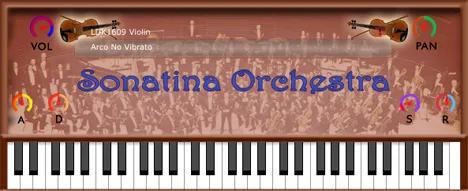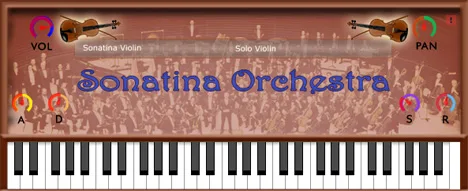In the world of digital music creation, virtual instruments have become an integral part of the workflow for millions of producers, composers, and musicians. They allow access to a wide range of sounds, from synthesized timbres to realistic emulations of acoustic instruments, without the need for a physical instrument or expensive studio recordings. This is especially true for orchestral instruments like the violin, one of the most expressive and rich sounds in music.
For those seeking a quality and, importantly, free solution for adding a violin to their tracks, there’s the LDK1609 Violin plugin from bigcat Instruments, known for its free developments. This virtual instrument is based on samples of a real violin and is designed to provide musicians with the authentic sound of this wonderful instrument.
Authentic Sound: Samples of the E H Roth 1925 Violin
The key factor determining the quality and realism of a virtual instrument is the quality of the samples it’s based on. In the case of LDK1609 Violin, the foundation was recordings made by a talented member of the freesound.org community under the nickname LDK1609. These samples have special value as they were recorded using an E H Roth violin made in 1925. The instruments of the master Ernst Heinrich Roth are known for their high-quality craftsmanship and excellent, rich tone. Violins created during this period often have a deep, resonant sound that results from the craftsmanship and the age of the wood, which only improves its acoustic properties over time. Using samples of such an outstanding instrument gives the LDK1609 Violin a special depth and character, distinguishing it from many other virtual violins.
Six Articulations for Maximum Expressiveness
To truly imitate playing a live instrument, a virtual plugin must provide the ability to use different performance techniques or articulations. The LDK1609 Violin copes perfectly with this task, offering the user six switchable groups of samples, each corresponding to a specific violin playing technique. This allows for the creation of a more realistic and dynamic part, choosing the appropriate articulation for different musical phrases or sections of a composition.
Available Articulations:
- Arco no vibrato: Standard bowing technique, without added vibrato. This articulation is useful for playing long notes, creating background string parts, or excerpts where a clean, stable sound is needed without the emotional coloring that vibrato adds. It’s suitable for classical music where vibrato is not always mandatory or used sparingly.
- Arco vibrato: Playing with the bow with vibrato. This is perhaps the most commonly used technique for playing melodic lines in most genres. Vibrato adds warmth, expression, and volume to the notes, making the sound more “alive” and emotional. Using this articulation allows the violin part to stand out and carry the main melodic or harmonic line.
- Pizzicato no vibrato: Pizzicato technique without vibrato. This is a plucking method that gives a short, sharp sound that fades quickly. Pizzicato is great for creating rhythmic parts, chords, or special effects. The non-vibrato version is standard for classical pizzicato.
- Pizzicato vibrato: Pizzicato with vibrato. This articulation is less traditional for the violin and may add a very subtle oscillation to the decaying sound or has been included for experimentation. It can give an unexpected, interesting shade to plucked parts.
- Spiccato: Bowing technique in which the bow lightly hits the string and bounces off. This creates short, clear, and bouncy notes. Spiccato is often used for fast, virtuoso passages, light, graceful melodies, or to create a sense of movement and rhythm in the string section.
- Tremolo: The technique of rapidly repeating a single note with short bow movements. Tremolo creates a trembling, tension, or dense sound mass effect. It’s extremely effective for creating a dramatic atmosphere, emphasizing climaxes, or imitating the sound of a large string group.
Versatility and Accessibility
Thanks to the availability of these various articulations, LDK1609 Violin becomes a versatile instrument, able to adapt to the needs of a wide variety of musical genres and styles. It can be used to create realistic orchestral arrangements, add emotionality to cinematic music, bring elements of folk or ethnic music into modern tracks, or even for experimental soundscapes. Regardless of your musical direction, this plugin provides a high-quality and expressive violin sound.
Developed by bigcat Instruments, this plugin supports the popular VST and AU formats, ensuring compatibility with most modern Digital Audio Workstations (DAWs) on Windows (32-bit and 64-bit) and macOS operating systems. This makes it easy to integrate into your existing workflow.
Finally, it’s important to emphasize that LDK1609 Violin is completely free. This makes it accessible to everyone, from beginners just learning the basics of music creation to experienced professionals looking for quality instruments for their projects without significant financial costs. Accessing such a high-quality sampled instrument, based on a recording of an antique violin, is a great opportunity for any musician or producer.
If you aim to enrich your music with the authentic and expressive sound of the violin, LDK1609 Violin from bigcat Instruments is an excellent choice. Its diverse articulations, high-quality samples of an antique instrument, and complete free-of-charge nature make it a valuable addition to any virtual instrument collection. Download it today and start creating music with the soul of strings!



